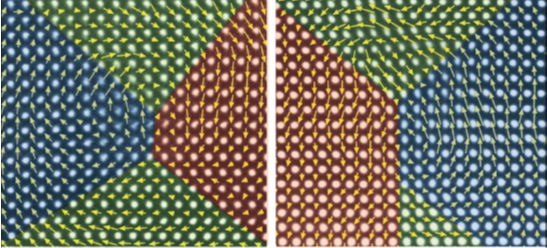The scientists from Institute of Metal Research, Chinese Academy of Sciences (IMR, CAS) recently fabricate periodic arrays of flux-closure domains in ferroelectric thin films with oxide electrodes. The findings are reported on 31 July 2017 as the cover article in Applied Physics Letters, from AIP Publishing. This work was performed by a research team with leading scientists of Prof. MA Xiuliang, Prof. ZHU Yinlian and their Ph.D student LI Shuang at the Solids Atomic Imaging Division, Shenyang National Laboratory for Materials Science, IMR, CAS.
Full flux-closure domains are microscopic topological phenomena found in ferroelectric thin films that feature distinct electric polarization properties. These closed-loop domains have garnered attention among researchers studying new ferroelectric devices, ranging from data storage components and spintronic tunnel junctions to ultra-thin capacitors. However, generally scientists have thought that oxide electrodes would destabilize flux-closure domains.
Based on their previous studies, the above team consequently anticipated that similar phenomenon might also occur in PTO/electrode systems. They then grew PTO films sandwiched between symmetric oxide electrodes on GSO substrates using pulsed laser deposition. They used two types of oxide electrodes: one based on strontium ruthenate, the other based on lanthanum strontium manganite, chosen as oxide electrodes because of their similar perovskite structures, which work well in layer-by-layer film growth. They found that periodic flux-closure arrays can be stabilized in PTO films when the top and bottom electrodes are symmetric, while alternating current domains appear when they apply asymmetric electrodes. This work will shed light on understanding the nature of flux-closure domains in ferroelectrics, and open research possibilities in the evolution of these structures under external electric fields.

Figure. Flux-closures in a PTO film with top and bottom SRO oxide electrodes grown on the GSO (110) substrate (Image by IMR)